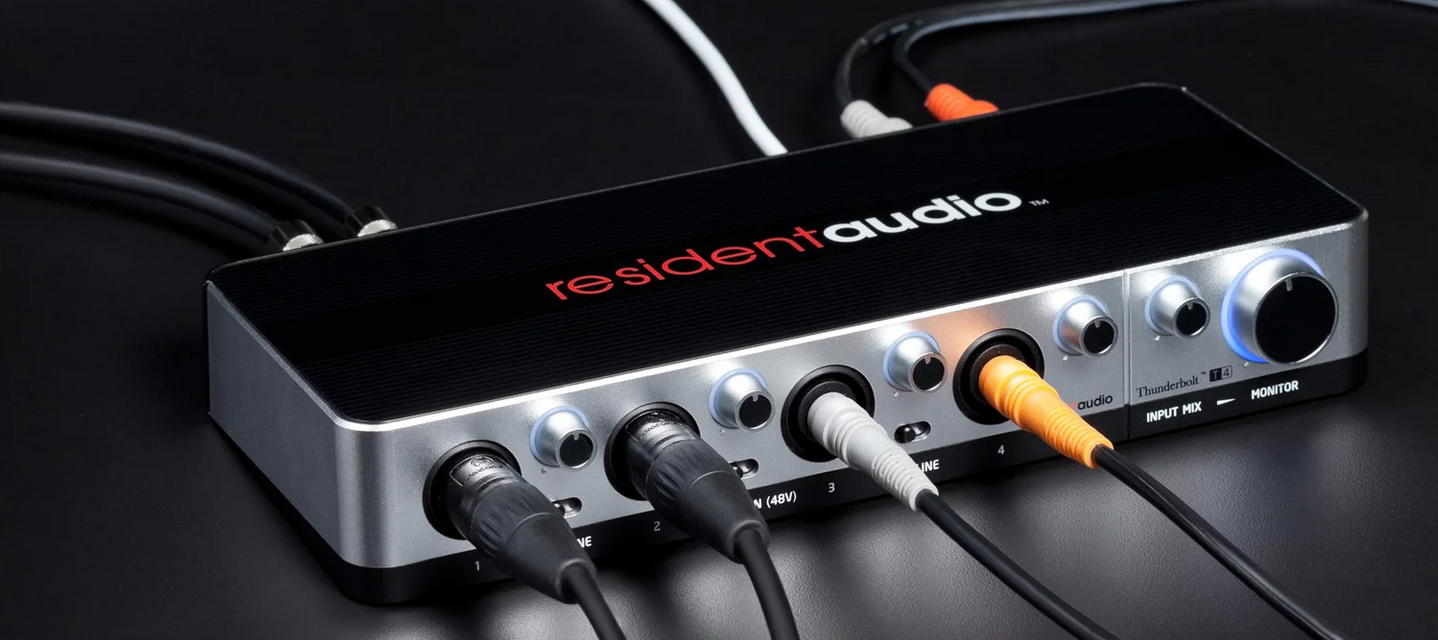Check out the T4 at Resident Audio: http://bit.ly/1C8NzVQ
Buy the T4 here: http://bhpho.to/1yjCgcj
I recently picked up a Thunderbolt audio interface. The one I picked is the Resident Audio T4. In this video I’m going to give you an overview of it, cover some of the features, and a bit about why I chose it.
Thunderbolt
Let’s first talk about why Thunderbolt. Thunderbolt is a newer and faster interface than USB or Firewire. It’s used to communicate with and power peripherals. It’s twice as fast as USB 3.0, twenty times faster than USB 2.0 and twelve times faster than Firewire 800.
With the increase in bandwidth, a Thunderbolt audio interface can have lower latency and higher-resolution audio. In this case, the T4 boasts 24 bit, 96K audio with virtually no latency. This is a really tangible benefit for me, because I run my saxophone and a synth in my live set. I need super solid performance with very low latency to play these instruments alongside my music.
Another benefit of Thunderbolt is that it can supply a full 10 Watts of power, as opposed to USB which has a maximum of 2.5 – 5 Watts. So the unit not only bus powers without the need for a separate power connection, and Resident Audio was also able to use components that require more power and are higher quality. For example, the T4 has 8 custom designed analog pre-amps (2 per channel).
In order to use the card, you’ll need a Thunderbolt equipped computer and Windows 8 on PC and OSX Mavericks on Mac or higher.
Front Panel
Let’s take a look at the front panel. We’ve got 4 inputs that can handle XLR or 1/4”. Each one has an input gain knob, a mic/line level switch, and can supply Phantom power. You also have a volume control for your input mix and mains. One sweet feature is that each gain and volume knob has a multicolor light ring around it, which indicates the amplitude of your signal so you can see if you’re clipping without looking at the software control panel. The main volume knob is nice and fat too, which is a plus because I like the hands on control.
Rear Panel
Let’s flip around to the back panel. We have 4 balanced 1/4” outputs, a stereo headphone out, the Thunderbolt connection, and MIDI in and out. The MIDI aspect is a nice addition that you don’t see on some smaller soundcards. Another thoughtful feature is a second headphone out. Output 3 has a headphone icon above it, and you can plug an additional set of phones in there, with a full stereo signal. This is useful if you’re tracking a vocalist, or if you’re collaborating with someone in the studio and you both want to listen on cans. As a design choice, I personally find it more convenient to have the headphone outs on the front panel, but it’s not a major inconvenience.
Control Panel
For software control, we have a very simple, straightforward control panel where you can link or gang input and outputs and set the sample rate. I’m hoping Resident Audio will continue to develop the control panel and add a few features like a sum output to mono and perhaps even onboard DSP for compression and EQ. But all things considered, the control panel gives you access to the core of what you need quickly and easily. And for the most part, you don’t even need to mess with the control panel because of the hands on control and multi color level indicators on the front panel.
Wrap Up
So to wrap up, here are my thoughts on it. The build quality is solid. It’s not all metal, so don’t go throwing it down a flight of stairs or anything, but it seems more than sturdy enough to venture out of the studio and onto the road. It’s lightweight and compact enough that I can see myself using it at gigs, especially with the low latency operation and bus power from the Thunderbolt. That’s what really makes it a winner. The fact that I can run up to 4 input sources at 24 bit 96K at virtually zero latency is massive. The pre-amps, AD and DA converters sounded great too, so whatever Resident Audio has chosen for components are clearly working. The sound quality rivals my Apogee Duet. Pricing on the card is about $500 US, which I’d say is bang on, given its feature set.
All things considered, I’m really happy with this interface and it’s currently my go to soundcard in the studio and for live shows. For more info about the T4 check out the links below. Catch ya next time.
Check out the T4 at Resident Audio: http://bit.ly/1C8NzVQ
Buy the T4 here: http://bhpho.to/1yjCgcj/a>



